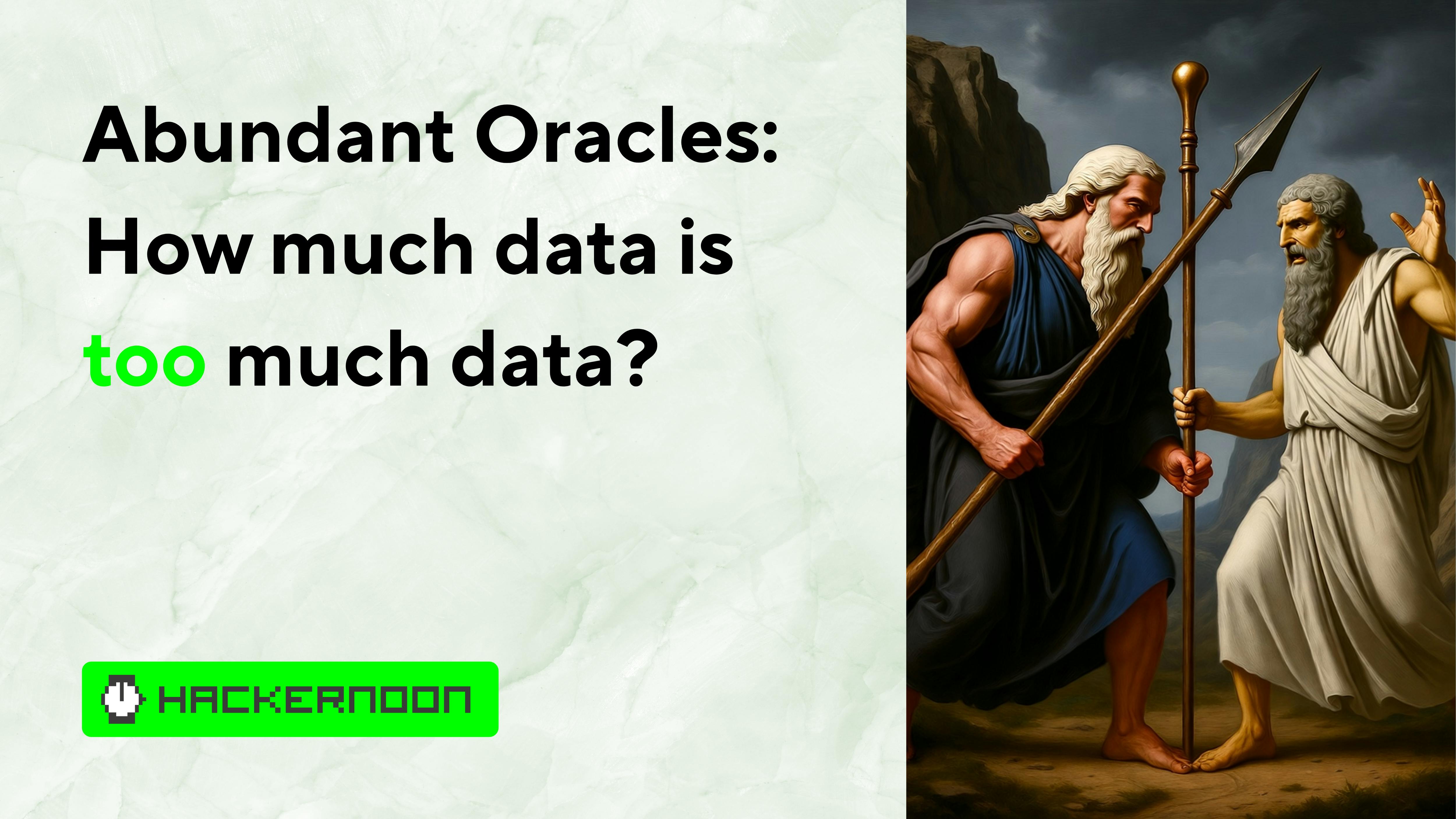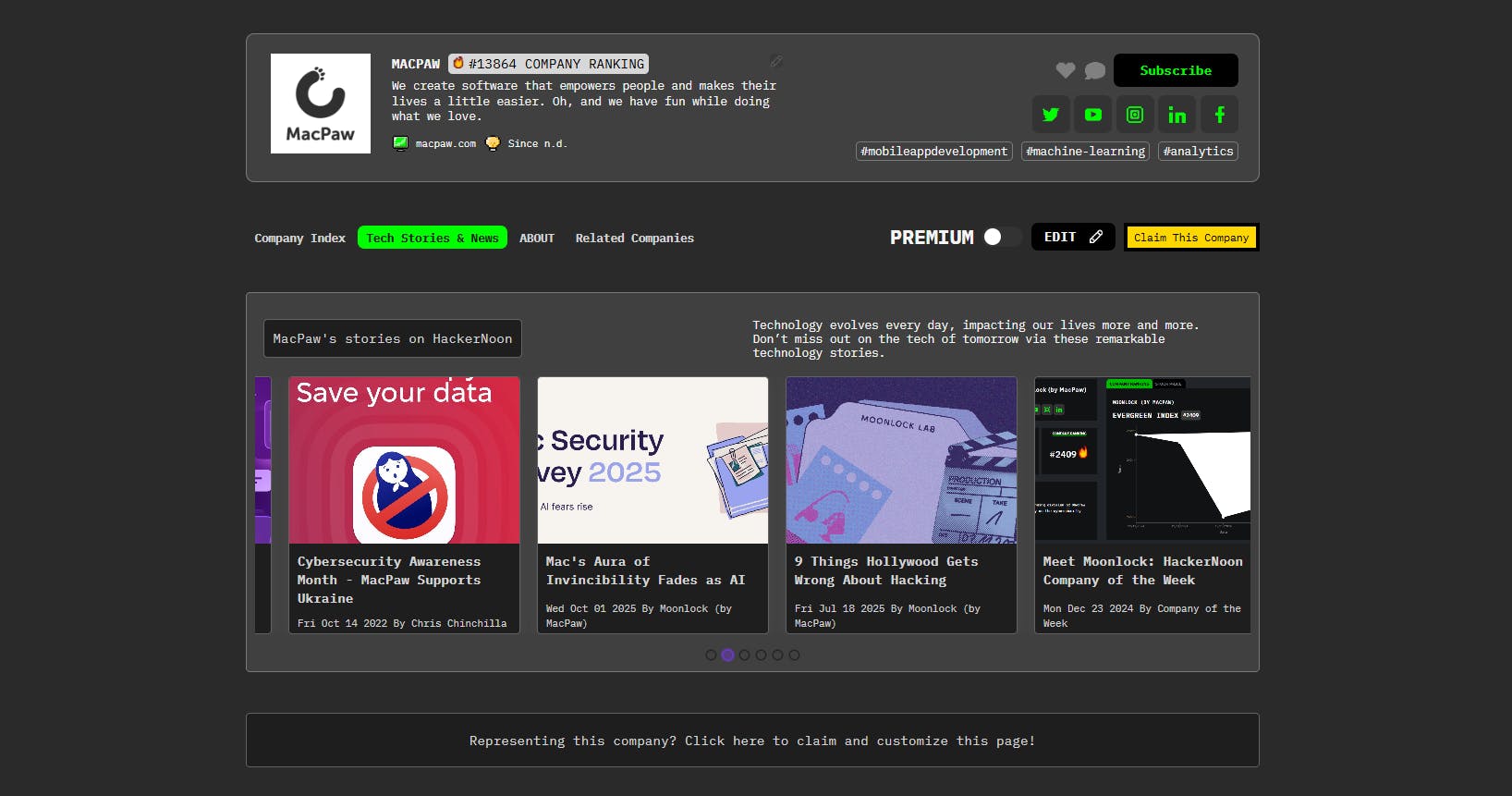Blockchain applications live and die by the data they consume. In decentralized finance (DeFi), gaming, and beyond, smart contracts rely on oracles, services that bridge onchain code with off-chain information. As the crypto industry has grown, so too has the number of oracle providers clamoring to feed blockchains with real-world data.
This explosion of abundant oracles raises a question: how much data is too much data? In other words, are we reaching a point where there are more oracle networks than the ecosystem truly needs, is it becoming a point of failure, and what does that mean for developers and users?
The Rise of Blockchain Oracles
Blockchains by design cannot directly access external data, a limitation known as the “oracle problem” (a great piece on the oracle problem was published back in 2019 by Hackernoon contributor Joshua Davies here). Oracles solve this by acting as data couriers that fetch and verify information from the outside world, be it market prices, weather, random numbers, and so on, and deliver it onchain. Without reliable oracles, many dApps simply couldn’t function. For example, a lending protocol needs up-to-date asset prices, and a blockchain game might need random numbers for fair loot drops.
Early on, projects often used centralized data feeds or single APIs, which introduced single points of failure. The push for decentralization led to the development of decentralized oracle networks that use multiple independent nodes and data sources to ensure integrity and availability.
Chainlink: The Dominant Oracle Network
We can’t write a detailed article about oracles without addressing the elephant in the room. One of the first major decentralized oracle solutions was Chainlink, launched in 2017. Chainlink set the standard for how to securely bridge blockchains and APIs, using a network of independent node operators and a native token (LINK) to incentivize accurate reporting. As of early 2024, Chainlink commanded about 60% of the entire oracle market share by market capitalization, securing tens of billions of dollars in value for smart contracts.
It’s hard to overstate Chainlink’s dominance in the oracle sector. With first-mover advantage and an aggressive integration strategy, Chainlink established itself as the go-to oracle network for developers seeking off-chain data.
By 2022–2023, it was securing hundreds of billions of dollars in DeFi value and counting major companies like Google and SWIFT among its partners for exploring oracle use-cases. Chainlink’s design, a push-model where oracles continuously broadcast updated data onchain, ensures that dApps always have fresh information. This approach has proven especially critical for volatile markets. For instance, stablecoin protocols and money markets depend on up-to-the-minute prices to avoid catastrophic under-collateralization.
Yet Chainlink didn’t rest on its laurels. It expanded its offerings beyond just price feeds. A notable example is Chainlink VRF (Verifiable Random Function), a random number oracle that launched on mainnet in late 2020. With VRF, smart contracts can obtain unbiased, verifiable randomness, which has been a boon for blockchain gaming, NFTs, lotteries and beyond. Chainlink VRF quickly became an industry standard for onchain randomness; by mid-2024 it had serviced over a million random number requests on Ethereum, Polygon, and BSC.
This early move into randomness helped Chainlink gain traction in the booming NFT and gaming sectors, on top of its DeFi stronghold. Developers valued that VRF provided provable fairness — for example, NFT projects like Axie Infinity used Chainlink VRF as far back as 2020 to ensure rare traits were assigned randomly and fairly. While VRF is just one part of Chainlink’s suite (which also includes services like Keepers for automation and CCIP for cross-chain messaging), it exemplifies how Chainlink kept innovating to maintain its dominance.
Chainlink’s prominence also drew attention to the importance of oracle security. With so much value depending on oracle data, any failure or exploit can be devastating. Indeed, the sector has seen nearly 900 million dollars lost in oracle-related exploits (e.g. manipulations of price feeds) since 2020.
Chainlink’s decentralized approach, where multiple nodes and data sources aggregate a single feed, is designed to reduce the risk of manipulation compared to a single-source oracle. This security-first reputation is another reason many platforms stick with Chainlink, it’s battle-tested.
However, the sheer reliance on one oracle network has prompted debate: is it wise for an entire ecosystem to lean so heavily on one provider? This question set the stage for a wave of new oracle projects that emerged to challenge Chainlink or serve niches it wasn’t filling.
A Crowded Oracle Ecosystem
Success breeds imitators, and the oracle space is no exception. Over the past few years, a plethora of oracle networks have launched, each claiming some improvement, be it lower costs, faster data, greater decentralization, or specialized data types. What we now have is a crowded oracle ecosystem: Chainlink at the top, and a long tail of alternatives competing for mindshare and integration deals.
On the surface, all oracle projects aim to do the same basic job, deliver off-chain data onchain, but they differentiate themselves in various ways. Some focus on the data sourcing model, for example, whether data comes directly from first-party providers or through intermediary nodes.
Others emphasize performance and cost, such as optimizing how data is delivered to be faster or cheaper. And some target specific blockchain ecosystems or data types, carving out a niche rather than going head-to-head with Chainlink for every market.
To illustrate the vibrant (and perhaps saturated) state of the oracle sector, here are a few notable oracle projects and what sets them apart:
-
API3 (First-Party Oracles): API3 is built on the idea of first-party oracles, where data providers (like SaaS companies or exchanges) operate their own oracle nodes to feed data directly to blockchains. In essence, it removes the middleman – instead of Chainlink’s network of third-party node operators fetching data from APIs, API3 enables the API providers to be the oracles.
The project’s Airnode technology provides a lightweight, serverless node that API providers can deploy easily. By eliminating intermediary nodes, API3 claims to improve security (less attack surface), transparency, and cost-efficiency for data providers. API3 is governed by a DAO (decentralized autonomous organization), reflecting a community-driven approach in contrast to Chainlink’s more centralized governance.
It even offers unique features like insurance – compensating users if its data feeds (dAPIs) malfunction. While some hyped API3 as a potential “Chainlink killer,” a more grounded view is that it targets a different segment of the market: projects that need custom, flexible data feeds and are sensitive to cost. In practice, API3 can be seen as a complement to Chainlink, tapping into providers and use-cases that a global network might overlook, and possibly coexisting by dividing the oracle market rather than replacing the leader.
-
Chronicle Labs (MakerDAO’s Oracle Spinoff): Chronicle Labs emerged from the MakerDAO ecosystem – in fact, it was founded by Niklas Kunkel, the developer of Maker’s first price oracles back in 2017. For years, Chronicle (though not publicly branded) operated as MakerDAO’s exclusive oracle, securing the collateral feeds for DAI and related DeFi platforms.
In 2023, MakerDAO provided a grant to spin out Chronicle as a standalone oracle network available to the broader Web3 community. Chronicle’s emphasis is on transparency and cost-efficiency. It offers an onchain dashboard called The Chronicle where anyone can trace data origins and verify how a price was determined. Under the hood, Chronicle uses a novel cryptographic primitive named Scribe to compress and publish data onchain more efficiently, reportedly cutting gas costs by over 60 percent on Ethereum (and near 70 percent on Layer-2 networks).
This is a big deal because oracle updates can be gas-intensive; Chronicle is basically saying it can deliver the same data for a fraction of the cost. By late 2023, Chronicle launched publicly with a network of community-run validator nodes and started serving projects beyond Maker, including integrations with partners like Spark Protocol (Maker’s lending dApp), Morpho, Euler, Coinbase, Circle, and others. In a landscape where Chainlink dominates, Chronicle Labs is leveraging its pedigree (Maker’s trust) and a promise of efficiency to carve a spot for itself.
-
Pyth Network (High-Frequency Data): Pyth Network is often mentioned in the same breath as Chainlink as a leading oracle network, particularly for high-speed financial market data. Backed by a consortium of trading firms and exchanges, Pyth takes a first-party data approach similar in spirit to API3 – its data publishers include major market makers and stock exchanges who directly contribute price quotes.
Pyth started on Solana in 2021, where its high-frequency price feeds (updated sub-second) could be delivered with low latency. It introduced an innovation called confidence intervals on its prices, giving dApps an indication of how volatile or uncertain the reported price is – a useful feature during turbulent market conditions.
Pyth has since expanded via cross-chain bridges to offer its data on over 50 other chains. Unlike Chainlink’s pure push model, Pyth uses a hybrid push-pull: data is continually published to the network off-chain, but onchain contracts pull in the updates when needed, which can save resources while still providing rapid updates. In terms of traction, Pyth is gaining interest especially for trading and derivatives platforms that value low-latency, institutional-grade data. Observers tend to see Chainlink and Pyth as serving different niches – with Chainlink entrenched in mainstream DeFi, and Pyth aiming at the high-performance trading niche – and often both can thrive.
-
Band Protocol (Cross-Chain Oracles): Band Protocol was one of the early competitors to Chainlink, launching on the Cosmos network. Band focuses on being a cross-chain oracle solution, operating its own high-performance blockchain (BandChain) to collect and package data, which can then be sent to other chains.
Thanks to Cosmos’s Inter-Blockchain Communication (IBC) protocol, Band can interoperate with many IBC-compatible chains, and it also provides bridges to non-IBC chains like Ethereum. Band had success around 2020–2021 especially in the Cosmos and Binance Smart Chain ecosystems, where it was sometimes the default oracle.
While its profile in Ethereum DeFi is lower today, Band still positions itself as a more scalable and chain-agnostic oracle network. Its design, using a delegated proof-of-stake blockchain, means data queries are handled by Band’s validators and results passed on, which can be efficient but introduces some latency. Band’s differentiator is being blockchain-neutral and optimizing for throughput, attempting to be a one-stop oracle for the multi-chain world.
-
Tellor (Crypto-Economic Oracles): Tellor takes a different approach, using a permissionless mining system rather than whitelisted node operators. Anyone can become a data reporter (a “miner”) by staking the Tellor token (TRB) and then competing to fetch and submit data points onchain.
If data is disputed (any TRB holder can challenge a reported value), a governance process determines the truth, and malicious reporters lose their stake. This “work contest” approach leans into crypto-economic guarantees – it’s like a decentralized trivia game where reporters race to provide the answer, and the network relies on game theory to ensure honest reporting. Tellor’s model is slower (data points may be updated only every 5–10 minutes, suitable for price feeds that don’t need second-by-second updates) and somewhat costly for reporters due to the competition.
However, it is highly decentralized and censorship-resistant by design, since no central party decides who can supply data. Tellor has found a niche for projects that value decentralization and onchain governance of their oracles above low latency.
-
UMA (Optimistic Oracle): UMA (Universal Market Access) is known for its novel “optimistic oracle” model. Instead of continuously pushing data onchain, UMA allows contracts to propose a value when needed, which is assumed correct unless someone disputes it within a time window.
In case of a dispute, UMA’s token holders vote to determine the correct value, and the system rewards or slashes participants accordingly. This scheme is very scalable for arbitrary kinds of data (because you don’t pay for an onchain feed until you actually need a data point). It’s used in contexts like prediction markets, derivative contracts, or any scenario where you only occasionally need a secure data resolution.
UMA’s oracle can be slower (dispute periods can be hours long), but it provides ultimate flexibility. Essentially any verifiable question (like “what was the outcome of X event?” or “what’s the 30-day volatility of asset Y?”) can be resolved through the optimistic oracle. This makes UMA more of a “truth machine” for one-off queries rather than a continuous price feed provider.
-
RedStone (On-Demand Data Feeds): RedStone is a newer entrant that has innovated on how data is delivered to contracts. RedStone uses a pull-based model with off-chain caching – their oracle nodes do not immediately publish data onchain. Instead, data is signed and stored off-chain, and when a smart contract needs a price, it can fetch the latest signed data and verify the signature on the fly.
In fact, RedStone can package recent price data into the transaction that triggers the smart contract, avoiding the need for constant onchain updates. This approach can significantly reduce gas costs and congestion because data is supplied just in time. RedStone has marketed itself as a modular and developer-friendly oracle, letting projects customize data sources and frequency.
It gained traction providing price feeds for many newer DeFi protocols (especially in the emerging liquid staking and re-staking sectors) by being willing to list newer, long-tail assets that big oracles hadn’t yet integrated. By 2024 RedStone was reportedly one of the fastest-growing oracles, supporting over 1,000 data feeds and dozens of protocols that use both RedStone and Chainlink in tandem.
This suggests an interesting trend: some projects use multiple oracles – e.g. Chainlink for mainstream assets and RedStone for niche tokens – which again points to a divided market where many oracle providers can find their sweet spot.
The above list is not exhaustive – there are even more projects out there, from DIA, which crowdsources and verifies data feeds, to powerful new entrants like Witnet, a purpose-built oracle blockchain.
Not to mention Binance Oracle and other centralized exchange-run oracles. The takeaway is that the oracle arena has become quite crowded. Some would say, saturated.
Is the Oracle Space Saturated?
Given this abundance of oracle projects, one might wonder if the space is oversaturated. Have we reached a point of diminishing returns where new oracle networks are redundant? Or does this intense competition actually benefit the crypto ecosystem? The answer may be a bit of both.
On one hand, multiple oracle networks competing can drive innovation and resilience. Chainlink’s dominance was not left unchallenged – competitors like API3 pushed the idea of first-party data feeds, Pyth pushed improvements in speed and quality, RedStone explored novel delivery mechanisms, and so on.
Each new approach forces existing players to evolve. For example, Chainlink has in fact adopted some ideas like decentralized data verification and off-chain reporting to reduce costs, partially inspired by seeing others address those pain points. And from a security standpoint, having alternatives is healthy: if one oracle network goes down or is compromised, having others available can act as a fallback.
We’ve even seen projects mix and match oracles (using a primary and a backup, or different oracles for different data types) to hedge against any single point of failure. We actually saw the result very recently, two days ago in fact at the time of writing, when the crypto market crashed in cascading liquidations and many oracles couldn’t keep up with accurate price feed data.
The “oracle wars” narrative has also spurred all providers to be more transparent and rigorous – knowing that nearly 892 million dollars has been lost to oracle exploits historically keeps the focus on security measures and auditing across the industry.
On the other hand, the proliferation of oracle projects can lead to fragmentation and confusion. Every oracle network typically has its own token, its own integration SDK, and often a unique set of data feeds. For developers, choosing an oracle can be tricky: do you go with the established player, such as Chainlink, for trust, even if it costs a bit more and might not support every asset you need? Or do you opt for a newer oracle that’s cheaper or covers niche data, but perhaps is less battle-tested?
The risk is that smaller oracle networks may not have the same security track record, potentially exposing projects to unforeseen vulnerabilities. Furthermore, if data for the same asset is coming from multiple oracle networks in parallel, it could create inconsistencies.
Imagine one oracle reports BTC price as $110,100 and another as $110,900. Arbitrageurs or attackers might exploit these differences if a protocol hasn’t carefully designed around one source of truth. This is why many DeFi protocols will explicitly pick one oracle source and stick to it for consistency. The saturated market thus forces a competitive filtering: only those oracle services that prove reliable and accurate will be able to win integrations over time. We may eventually see consolidation, where perhaps a few large oracles and a few niche specialists survive, while others fade away.
There’s also the question of economics. Oracles capture value through their tokens. If too many oracle tokens are chasing a limited number of integration opportunities, some may struggle to accrue value or sustain their node operator communities. Chainlink’s LINK has the advantage of high demand and usage across many apps, whereas a smaller oracle network might not generate enough fees to incentivize a robust set of node operators in the long run. In that sense, the market might not support dozens of parallel oracle networks all delivering the same kind of data. Eventually the ones with the best reputation, adequate decentralization, and sufficient economic incentives will outcompete the rest. You could argue this has already happened, with Chainlink and API3 as the immovable ‘Google’ and ‘Meta’ of the oracle space.
From a data perspective, the phrase “too much data” also hints at another issue: volume and quality vs. necessity. Oracles are bringing ever more data onchain – not just crypto prices, but sports scores, weather info, random numbers, any API imaginable. This enriches what smart contracts can do, but it also raises questions about cost and performance. Flooding a blockchain with updates for every little piece of data could bloat blocks and increase gas fees.
The community has noticed that constant oracle updates can be costly, especially on busy networks. That is why newer models (pull-based or on-demand oracles) aim to minimize unnecessary data publication. In an environment with abundant oracles, efficiency becomes a differentiator – whoever can deliver the right data at the right time with minimal overhead provides real value.
In summary, the oracle space indeed feels saturated, but that saturation is the crucible of progress. We have a rich array of oracle solutions now, decentralized networks, first-party data feeds, Layer-2 oracles, optimistic oracles, and more – all competing and co-evolving.
Rather than one size fits all, it’s likely different use cases will gravitate toward different oracle designs. We shouldn’t think in terms of a single “oracle champion” taking all; instead, projects like Chainlink and API3 (and others) can jointly divide the market, each serving the segment of users that value what they do best.
Chainlink’s broad adoption will continue for big players that need proven reliability and broad coverage. Meanwhile, up-and-comers will scoop up the long-tail needs – whether that’s an oracle for a bespoke dataset, or a cheaper service for budget-conscious startups.
Conclusion
So, how much data is too much data? In the oracle realm, having more data providers isn’t inherently bad. It means decentralization and choice. The real challenge is ensuring the data remains trustworthy, timely, and used judiciously. The abundance of oracles today signals a maturing market: one that has moved past being a monopoly of one or two providers into a diverse ecosystem of services. Yes, it can feel overwhelming that there are so many oracle networks all shouting for attention. But this abundance forces each to sharpen its value proposition.
For developers and blockchain builders, the key is to choose wisely. Evaluate what an application truly needs: ultra-fast updates, maximum security decentralization, low cost, or niche data sources. There’s probably an oracle for that. The space may consolidate in time, or new leaders like Chainlink may absorb lessons from rivals and remain on top. Conversely, a new breakthrough, perhaps oracles leveraging zero-knowledge proofs or AI for data verification, might disrupt the disruptors.
In any case, oracles remain an indispensable component of Web3’s infrastructure. The competition between them is ultimately a boon for the industry’s robustness. The fight of the oracles is far from over and will continue to spur additional innovation, benefiting the entire ecosystem. In the end, the goal for all these projects is aligned: empowering smart contracts with trustworthy data.
As long as they deliver on that, having an abundance of oracles isn’t too much of a good thing, it’s a sign that decentralized tech is flourishing. The crypto world will sort out which oracle networks prove worthy, and users will be better off for the abundance of choice, not worse. After all, in the quest for truth on the blockchain, more eyes on the data can mean more security, and more ideas on how to feed that data can only make the system stronger.










